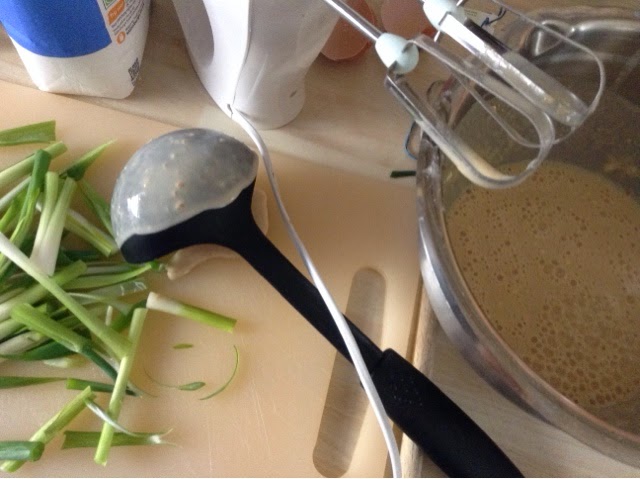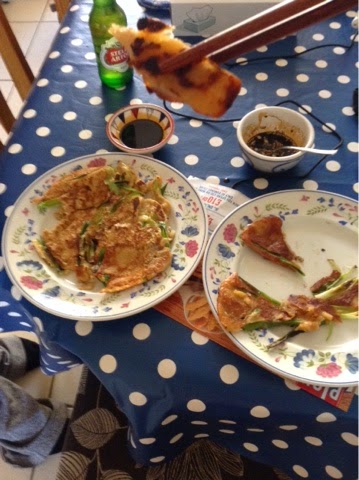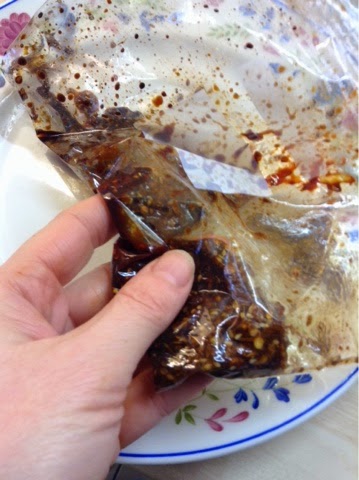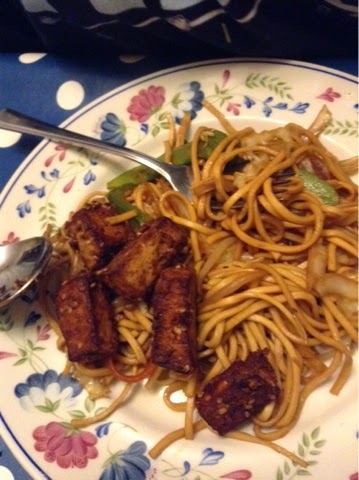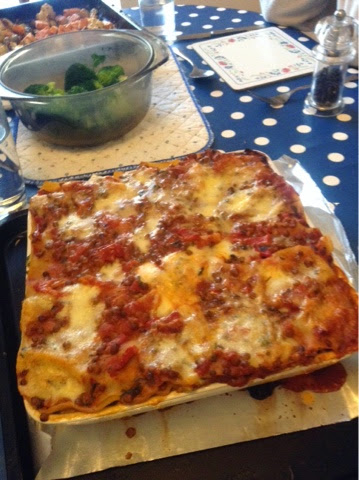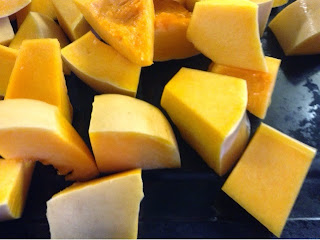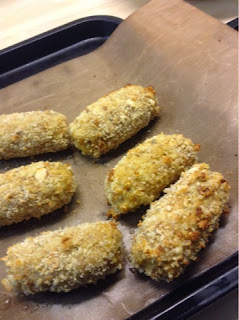
Many years ago, before veggie daughter and her brothers were even thought of and when their dad and I were impoverished students, we decided that we would eat more vegetarian food to save money. There were many spectacular failures, but a recipe that we returned to many times was one for baked soya bean rissoles. A crispy breadcrumb coating encased a creamy mixture of soya beans and seasonings. The recipe came from a magazine, I have no idea of the title, and the torn out page became increasingly dog-eared and eventually got lost.
Since then I have searched in vain for it online and in many vegetarian cookbooks. Determined to introduce veggie daughter to these delights, I decided that I would try to recreate them. I could remember quite a few of the ingredients, including the fact that they had a white roux or bechamel sauce base. It also occurred to me that they may not have been called rissoles, but rather croquettes. So I googled 'croquettes bechamel sauce'. Bingo! Well almost. The search revealed several recipes for Spanish croquettes (croquetas), but no soya bean version. The versions I found had ham, cheese and chorizo in varying combinations, stirred into a bechamel sauce, coated with breadcrumbs and deep fried, which sound delicious, but would not do for my current purposes.
One thing I do remember about the recipe was that it was quite a pain to make, with the soya beans needing to be soaked, then cooked in the pressure cooker, which always made a huge mess as they were guaranteed to froth up and overflow. I also remember that shaping the croquettes was a complete sticky nightmare, with my fingers each looking like a breaded croquette at the end of the process. We used to make up a massive batch and freeze them to avoid the inevitable major kitchen clean up happening too often. Now the recipes for the Spanish croquettes all called for the bechamel to be made very thick, then left to cool and set for at least an hour or two before attempting any shaping into croquettes. An aha moment! I remember that the mixture was always warm when I tried to shape my croquettes and concluded that therein lay the reason for the sticky nightmare.
The other difference was that our croquettes were baked in the oven rather than deep fried. Now I'm sure they would be totally delicious deep fried, but I'm not a fan of the actual process with the mess it entails along with the pervading smell that lingers for days afterwards, not to mention that deep frying is not exactly the healthiest cooking method. I wouldn't rule out frying a batch in future as a treat, but for this batch I wanted to bake them in the time honoured fashion of the old recipe. So back to google to search for 'oven baked Spanish croquette' and I find this rather tasty sounding recipe for
oven-fried Spanish croquettes on the rather oddly titled website Gimmesomeoven.com. I decided to use their method for cooling and setting the bechamel mixture and for baking the shaped croquettes. I winged the rest of the recipe, but fortunately it worked! I made half the batch without cheese for dad, but veggie daughter and I preferred the cheesy ones. I think the croquettes were somewhat firmer than the old recipe, and veggie daughter was not entirely convinced that she liked the texture of the bean mixture, but on balance they received the seal of approval.
A note on the addition of smoked garlic. As far as I can remember, the original recipe did not have garlic, but I was intrigued to see smoked garlic on sale in the local supermarket. It smells delicious, almost like chorizo, which I thought would be a nod to the Spanish croquette recipes I saw.
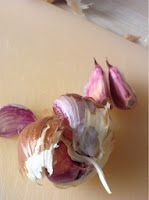 |
| Smoked Garlic - a great new discovery! |
Baked Soya Bean Croquettes
Makes 12 (enough for 3 people)
150g dried soya beans
2 bay leaves
450ml semi skimmed milk
1 small onion or shallot
50g sunflower margarine (or butter)
50g cornflour (cornstarch in the US/Canada)
25g wheatgerm
1 clove smoked garlic, crushed
1/2 tsp smoked paprika
1 tsp dried mixed herbs (eg oregano, basil, thyme)
salt and pepper
70g cheddar cheese, grated (optional)
1 egg, beaten
70g breadcrumbs (I made my own from stale bread, processed in the food processor then lightly toasted to dry them out in the oven, but panko or other packet breadcrumbs would work fine)

1. Cook the soya beans. If cooking in a regular saucepan they will need overnight soaking, then fast boiling for about 10 minutes, before simmering for about 3 hours. I used a pressure cooker, and covered the beans in boiling water before leaving them to soak for one hour. Drain and rinse, then put in the pressure cooker with 300ml water and a bay leaf (no salt or they will toughen). Bring to the boil in the open cooker, skim off any scum, then get them to the point where they are boiling but not rising up in the pan. Close the pan and bring to pressure and cook for 22 minutes. Switch off the heat and leave the pressure to come down on its own before opening the cooker. This was the first time I have ever cooked them without them overflowing - perhaps because it was a small quantity, but I was careful not to turn the heat up too high and the beans were cooked to perfection.
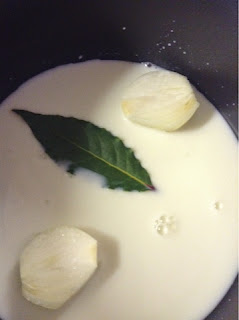
2. Meanwhile peel the onion and put in a heavy saucepan with the other bay leaf and the milk. Bring to the boil, then take off the heat and leave to infuse for an hour or so.
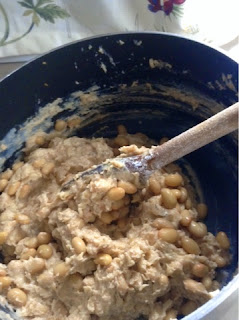
3. Make the bechamel sauce: melt the sunflower margarine, stir in the cornflour and cook gently for 2 or 3 minutes, stirring constantly. Stir in the strained milk and heat until thickened, stirring to get rid of any lumps and to stop the mixture from sticking. Stir in the wheatgerm, smoked garlic, paprika and herbs. Taste and season with salt and freshly ground black pepper. Mix in the cooked, strained beans and the cheese if using. Cover and leave in the fridge for an hour or two to set firmly.
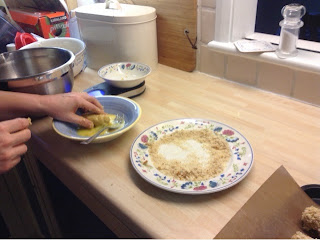
4. Put the beaten egg in a bowl, and the breadcrumbs on a plate. Shape 50g lumps of the mixture into logs and dip each into the egg, then roll in the breadcrumbs to coat. Place on an greased baking tray. Put them in the fridge for at least 20 minutes to firm up before baking.
5. Preheat the oven to 200 degrees C. Spray the croquettes with olive oil or cooking spray, then bake them for about 15 minutes until they are golden brown.
I served them with stir fried bok choi and sugar snap peas, tomato sauce (recipe in the next post) and baked sweet potato wedges (peel and slice the sweet potatoes lengthwise into wedges, toss with sunflower oil, salt and pepper and bake for 30 minutes or so until browned and cooked through).
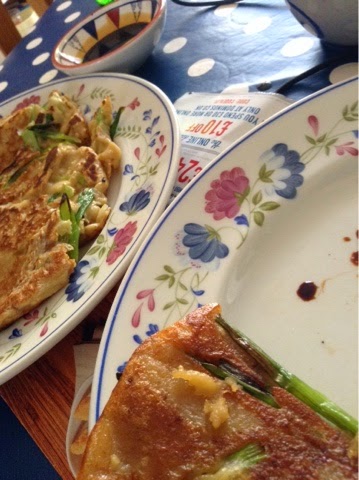 When veggie daughter was just 4 months old we upped and moved from the UK to live in Seoul, Korea for five years. As a result the whole family developed a strong taste for the delights of Korean cuisine. Now, eleven years after leaving Korea this still often manifests itself as an irresistible craving for some kimchi, or maybe a bowl of soft tofu stew or bibimbap.... Sadly, Korean restaurants are few and far between where we now live, although we did just discover a new bibimbap restaurant in Cambridge last weekend.
When veggie daughter was just 4 months old we upped and moved from the UK to live in Seoul, Korea for five years. As a result the whole family developed a strong taste for the delights of Korean cuisine. Now, eleven years after leaving Korea this still often manifests itself as an irresistible craving for some kimchi, or maybe a bowl of soft tofu stew or bibimbap.... Sadly, Korean restaurants are few and far between where we now live, although we did just discover a new bibimbap restaurant in Cambridge last weekend. 